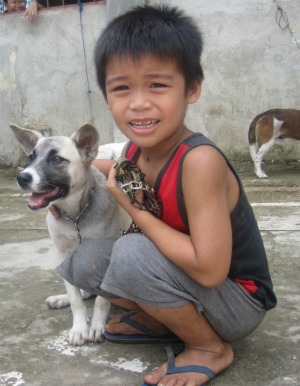The Bohol Rabies Project: A Model for a Sustainable Rabies Prevention and Elimination Program
Rabies, perhaps the oldest infectious disease known to man, is an illness of stunning lethality. As Charles Rupprecht, director of the U.S. Center for Disease Control’s Rabies Program, puts it: “Rabies has the highest case fatality rate of any conventional infectious agent, essentially approaching 100 percent.” In the 4,000 years that mankind has been aware of rabies, only a handful of people have ever survived the disease and only then with massive high-tech intervention. Worldwide an estimated 55,000 people (on average, one every 10 minutes) die each year from rabies. The vast majority are from Asia or Africa. That’s bad news.
The good news is that rabies is almost entirely preventable. More than 99 percent of all global human rabies deaths are believed to occur as the result of exposure to infected dogs. Vaccinate the dogs against rabies, and you eliminate all but a tiny sliver of the rabies threat. Further, modern post-exposure treatment is highly effective in preventing rabies if administered promptly.
In the Philippines, as in most Asian countries, canine rabies is endemic and poses a risk for people living in rural areas. An average of 250 human deaths has been reported there annually over the last 10 years. Almost all deaths were because the patient failed to seek post-exposure treatment due to a lack of educational awareness. In 2006, Bohol, an island province of the Philippines with a population of 1.13 million people, was ranked the fourth highest region in the country for human rabies deaths, averaging 10 per year.
The 2000 Attempt to Control Rabies in Bohol
In 2000, the first province-wide rabies mass dog vaccination program was conducted on Bohol. This program was directly supported by the national government and involved only the existing veterinary service staff. Although this campaign reached a satisfactory level of dog vaccination, the following year, in 2001, the dog vaccination coverage on Bohol had dropped to two percent and no allocation had been made for the purchase of vaccine in the succeeding years. Rabies control was not sustained, and inevitably, canine rabies recurred and spread. As a result, the number of human rabies cases began to steadily increase.
 |
|
| In the Philippines around 250 people die of rabies a year. Children are at high risk from rabies as they tend to play with dogs and may not recognize abnormal behavior in dogs. |
The Bohol Rabies Prevention and Elimination Project: The Plan
In 2007, Dr. Stella Marie Lapiz, provincial veterinary officer for Bohol, working with Dr. Mary Elizabeth Miranda, Asian projects coordinator for the Global Alliance for Rabies Control, began development of the Bohol Rabies Prevention and Elimination Project (BRPEP). The goal was to build a sustainable program that would prevent human rabies by eliminating rabies at its source in dogs by 2010.
At the heart of BRPEP was what might well be called “saturation collaboration.” The idea was to build a groundswell of support for BRPEP by involving participation of every relevant sector of Bohol society, from the smallest village to the Philippine national government, including agriculture, public health and safety, education, environment, legal affairs, and interior and local government. The program included: increasing local community involvement; implementing dog population control; conducting mass dog vaccinations; improving dog bite management; instituting veterinary quarantine; improving diagnostic capability, surveillance and monitoring, and educating children about rabies and responsible dog ownership in local public schools.
From the outset, the objective was to build consensus throughout Bohol, to create and involve stakeholders at every level who were committed to building a rabies control program on Bohol that would not only eliminate dog rabies and protect humans from rabies, but would be self-sustaining when the outside funding channels were no longer available.
The Bohol Rabies Prevention and Elimination Project: The Implementation
The first phase was designed to provide the data needed to implement the large scale vaccination and education campaigns that were the core of the project. A survey collected data on the owned dog population; knowledge, attitudes and practices, and data regarding human-dog relationships in Bohol.
The implementation of the BRPEP required a huge increase in the number of people involved in rabies control. It increased from 124 government paid staff prior to 2007 to more than 15,000 people—mostly volunteers—in 2009. A special ordinance, stipulating the establishment of implementing bodies at the provincial, municipal, and village level and designed to work in concert with national anti-rabies laws, was passed by the Bohol provincial legislative body.
The legislation defined the roles and responsibilities of local rabies control councils including the organization of dog and dog owner registration; collection of registration fees; elimination of stray dogs; dog vaccination; surveillance of human and animal rabies and dog bite incidents; settlement of disputes and agreements between bite victims and dog owners, and promotion of responsible dog ownership. To ensure dissemination of information about the legislation and promote BRPEP, orientation and paralegal training sessions were conducted for 7,500 village-based and other volunteers, and teachers in all 962 Bohol public elementary schools.
Communication to facilitate understanding, cooperation, and support among the stakeholders—including the citizens living on Bohol island, medical professionals, volunteers and paid employees implementing the program as well as government officials and funding agencies—was considered critical from the inception of BRPEP. As a part of the communications effort, a BRPEP handbook was developed and distributed to every municipal rabies council to serve as a reference for all field units.
The handbook detailed the roles and responsibilities at various management levels, from national government down to local villages and individual households. It outlined BRPEP goals and objectives, strategies of implementation, program management, information on legislation and phone numbers to call in case of questions. A somewhat simpler village handbook was written in the local dialect and distributed to each of the 1,109 villages on Bohol.
Prior to the launch of BRPEP, there were only two government-operated Animal Bite Treatment Centers (ABTCs) on Bohol. As part of BRPEP, four additional privately operated ABTCs were established to increase access to timely post-exposure anti-rabies treatment. In addition, surveillance systems for both human and canine rabies cases were established in order to ensure immediate and reliable transfer of information and follow-up in the case of human or animal exposure to a confirmed rabid animal. In 2010, the Provincial Government allocated funds for the establishment of a Provincial Rabies Diagnostic Laboratory. The US Centers for Disease Control trained 12 local government veterinarians in rabies diagnosis using the direct rapid immunohistochemistry test.
A key element of BRPEP was the full integration of lessons on rabies and responsible pet ownership into the curriculum of all elementary schools throughout the province. The first province-wide implementation across public elementary schools in the Philippines, it proved that working with the educational system was an effective strategy for improving rabies awareness among youngsters who are most at risk to rabies exposure.
Dr. Adrian Vos, a global rabies expert who visited BRPEP in 2011, says, “Involving school children was very important. I believe that educating the children about rabies and responsible dog ownership can reduce the rabies cases by 50 percent.”
Management
BRPEP was led by the Governor of Bohol and administered through a group of departments working together at the provincial and local level, and supervised through the office of the Provincial Veterinarian. The Provincial Veterinarian coordinated canine rabies prevention and elimination while the Provincial Health Officer took charge of human rabies prevention and elimination. The Global Alliance for Rabies Control provided technical advice, and its Asian Projects Coordinator oversaw all stages of implementation through periodic site visits and participation in field activities.
High level BRPEP organizations were paralleled by Municipal Rabies Prevention and Elimination Councils and by the Bantay Rabies sa Barangay (rabies watchers at the village level). Membership in the municipal councils was designated by the mayors, and village level members of the project were chosen by the village captains. For the mass vaccination campaigns, teams were organized at the provincial and municipal levels.
Dr. Deborah Briggs, executive director of the Global Alliance for Rabies Control, says, “One of the keys to the success of the project is that the people of Bohol felt that they had ownership of this project at every level.”
Funding
Funding was a major hurdle for the BRPEP. Funding was secured from the national government; provincial, municipal and village governments, dog owners, NGOs, the regional office of the World Health Organization, the UBS Optimus Foundation, and the Global Alliance for Rabies Control. The Philippines National and Provincial Governments provided 477,550 CHF, and a UBS Optimus Foundation provided another 360,000 CHF. Total cost was $450,000 U.S. dollars.
Ann-Marie Sevcsik, program director in health for UBS Optimus Foundation, said, “The BRPEP shows how transformative community change can blossom when a project effectively engages people across different sectors and within the community, including children who are most vulnerable to rabies. We look forward to seeing how this model can be adapted and replicated in other geographic and disease contexts.”
Challenges
One of the key elements of BRPEP was the establishment of a 1 US$ dog registration fee that would provide funds for the continuation of the program after external sources were used up.
At the outset, naysayers from within the rabies-control community declared that it wouldn’t fly. In a country where many people earned less than 2 US$ per day, the dog registration fee wouldn’t work, they said; it couldn’t work.
In addition, says Dr. Stella Marie Lapiz, provincial veterinary officer, “During the social preparation for the BRPEP, it was difficult for local people to understand why they had to register their dogs. It was the first time that they had to pay for that.”
But the government subsidized the purchase of post-exposure treatment for people bitten by dogs whose owners had kept their animals registered and vaccinated, so the registration also acted as a kind of insurance for dog owners. In the end, the people of Bohol accepted the dog registration fee, and it now provides more than 100,000 US$ annually to sustain BRPEP, and the naysayers in the rabies control community have had to admit that dog registration program worked.
Another challenge, according to Ann-Marie Sevcsik, is “making sure that the data and the science are robust enough to give hard evidence of how great a program this is.”
The Results
 |
| On October 8, 2010, members of the project team celebrated two years without a single human or canine rabies case on Bohol. Photo: Global Alliance for Rabies Control |
A side effect of BRPEP is that vehicle accidents caused by stray dogs have also been reduced.
By Jock Elliott






